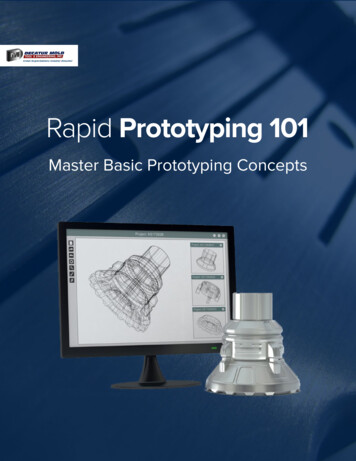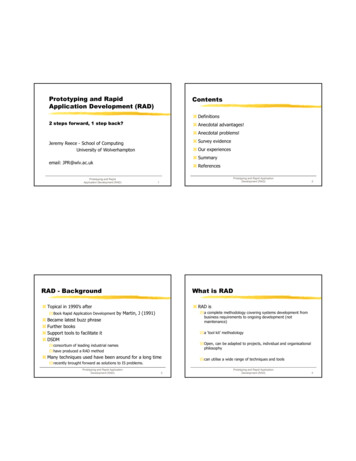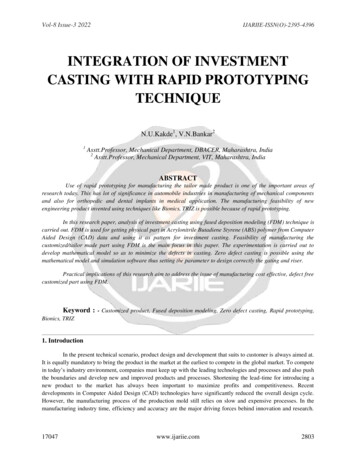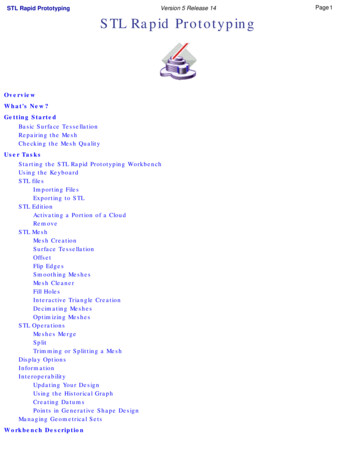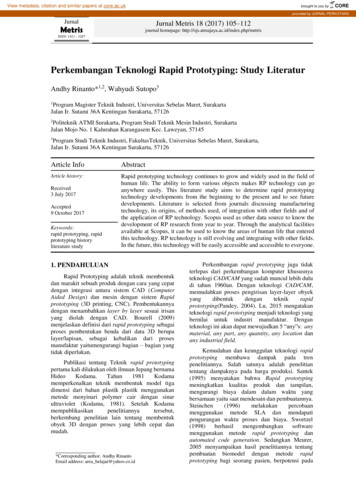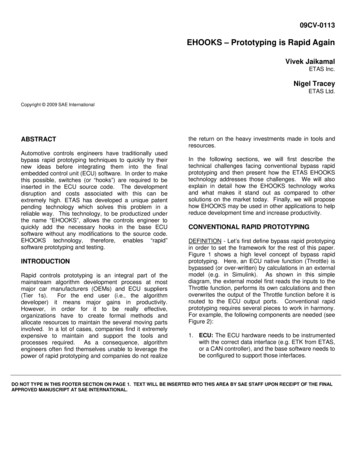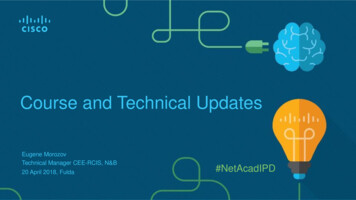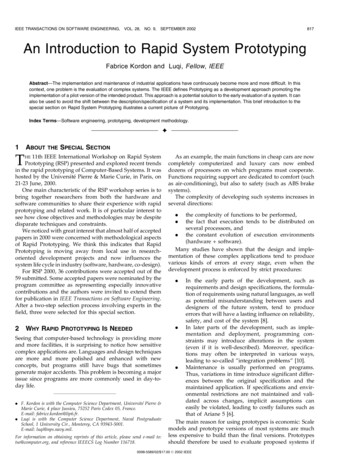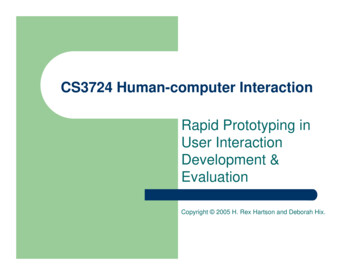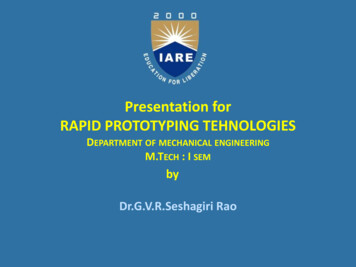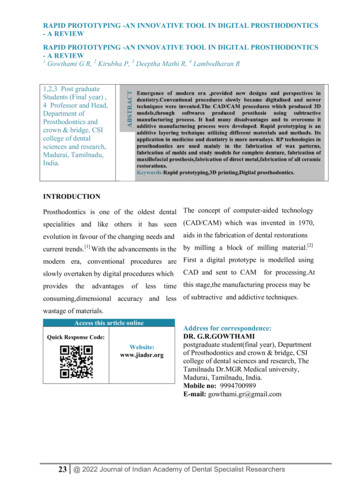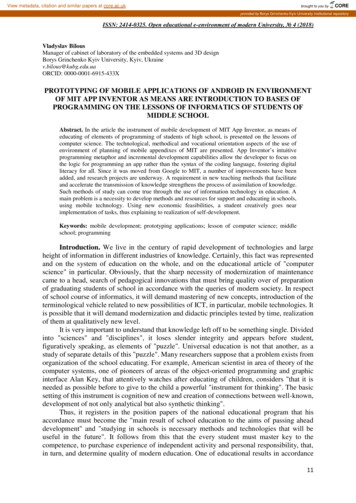
Transcription
View metadata, citation and similar papers at core.ac.ukbrought to you byCOREprovided by Borys Grinchenko Kyiv University Institutional repositoryISSN: 2414-0325. Open educational e-environment of modern University, 4 (2018)Vladyslav BilousManager of cabinet of laboratory of the embedded systems and 3D designBorys Grinchenko Kyiv University, Kyiv, Ukrainev.bilous@kubg.edu.uaORCID: 0000-0001-6915-433XPROTOTYPING OF MOBILE APPLICATIONS OF ANDROID IN ENVIRONMENTOF MIT APP INVENTOR AS MEANS ARE INTRODUCTION TO BASES OFPROGRAMMING ON THE LESSONS OF INFORMATICS OF STUDENTS OFMIDDLE SCHOOLAbstract. In the article the instrument of mobile development of MIT App Inventor, as means ofeducating of elements of programming of students of high school, is presented on the lessons ofcomputer science. The technological, methodical and vocational orientation aspects of the use ofenvironment of planning of mobile appendixes of MIT are presented. App Inventor’s intuitiveprogramming metaphor and incremental development capabilities allow the developer to focus onthe logic for programming an app rather than the syntax of the coding language, fostering digitalliteracy for all. Since it was moved from Google to MIT, a number of improvements have beenadded, and research projects are underway. A requirement in new teaching methods that facilitateand accelerate the transmission of knowledge strengthens the process of assimilation of knowledge.Such methods of study can come true through the use of information technology in education. Amain problem is a necessity to develop methods and resources for support and educating in schools,using mobile technology. Using new economic feasibilities, a student creatively goes nearimplementation of tasks, thus explaining to realization of self-development.Keywords: mobile development; prototyping applications; lesson of computer science; middleschool; programmingIntroduction. We live in the century of rapid development of technologies and largeheight of information in different industries of knowledge. Certainly, this fact was representedand on the system of education on the whole, and on the educational article of "computerscience" in particular. Obviously, that the sharp necessity of modernization of maintenancecame to a head, search of pedagogical innovations that must bring quality over of preparationof graduating students of school in accordance with the queries of modern society. In respectof school course of informatics, it will demand mastering of new concepts, introduction of theterminological vehicle related to new possibilities of ICT, in particular, mobile technologies. Itis possible that it will demand modernization and didactic principles tested by time, realizationof them at qualitatively new level.It is very important to understand that knowledge left off to be something single. Dividedinto "sciences" and "disciplines", it loses slender integrity and appears before student,figuratively speaking, as elements of "puzzle". Universal education is not that another, as astudy of separate details of this "puzzle". Many researchers suppose that a problem exists fromorganization of the school educating. For example, American scientist in area of theory of thecomputer systems, one of pioneers of areas of the object-oriented programming and graphicinterface Alan Key, that attentively watches after educating of children, considers "that it isneeded as possible before to give to the child a powerful "instrument for thinking". The basicsetting of this instrument is cognition of new and creation of connections between well-known,development of not only analytical but also synthetic thinking".Thus, it registers in the position papers of the national educational program that hisaccordance must become the "main result of school education to the aims of passing aheaddevelopment" and "studying in schools is necessary methods and technologies that will beuseful in the future". It follows from this that the every student must master key to thecompetence, to purchase experience of independent activity and personal responsibility, that,in turn, and determine quality of modern education. One of educational results in accordance11
ISSN: 2414-0325. Open educational e-environment of modern University, 4 (2018)with the requirements of state educational standard at all levels of universal education is ICTcompetence of student. In this connection the role of school course of informatics increasesconsiderably.Working at the computer, a student constantly runs into the "window" programs, in thatthere are the buttons, inscriptions, images, sounds, therefore in his understanding, program thathe makes must be the same. Instead, him one of programming languages is offered to: Basic orPascal. Going near their study is approximately identical in all textbooks: in an order to writethe program it is needed to consider a programming environment, program structure, syntax oflanguage, after students proceed to writing of the simplest programToday the teacher of informatics has unique possibilities of forming of cognitive interestof schoolchildren in the process of educating to programming, foremost, due to the widespectrum of the used software environments. So, for example, on the lessons of informatics atthe study of programming teachers are actively use visual environments programming (Scratch)oriented to development of "desktop" applications that, undoubtedly, causes large interest forschoolchildren, but dissatisfies him fully. It can be explained by that, besides computers, thestudent use mobile devices all anymore. Does a question get up before the teacher ofinformatics, how to convert a favorite toy into the means of educating.Most schoolchildren perceive the division of programming as difficult and boring, andlooks forward to, when he will make off. At the same time, educating to programming is veryimportant, and it would be desirable to organize this process so that he took not two-threepersons from a class, and would be interesting to all. One of ways of decision of this problemis the use of editor MIT App Inventor. MIT App Inventor is the programming environmentworked out by scientists from Massachusetts Technological Institute (MIT). Program isintended for development of appendixes for mobile devices (smartphones and plane-tablecomputers) working on the operating system Android.MIT App Inventor is an environment of visual development of Android- of appendixes.For development of appendixes knowledge of programming of Java and Android SDKlanguage is not required in MIT App Inventor, enough knowledge of elementary bases ofalgorithmization is at the level of high school. Dignity of this environment is that with her helpjust for a few minutes it is possible to create the elementary application, and for a hour - to buildthe difficult enough program with a few screens. (Fig.1)That he does not need to be set on a computer behaves to basic advantages of editor MITApp Inventor, he works straight from a browser, it is needed only to have Google account.Fig.1 Start screen application MIT App Inventor12
ISSN: 2414-0325. Open educational e-environment of modern University, 4 (2018)A programming of environment of MIT App Inventor language is very simple, as he fromthe beginning was created in order that he was used by schoolchildren. At programming on himit is not needed to write code lines, as it takes place on other programming languages. To createappendixes in MIT App Inventor, simply enough to drag blocks, collecting them in the program,as puzzle.Developing in the environment of App Inventor, students can be taught to work in acommand. Working in groups with App Inventor is not an easy task. Students can work togetherto plan their apps and share ideas, but when it is time to design and implement their apps, thetool has some limitations that make group work challenging. For example, blocks cannot becopied from one project to another, and two or more people cannot work on the same project atthe same time. Even with the limitations of App Inventor to support collaborative work, 68percent of the respondents agreed/strongly agreed they enjoyed working in teams to developmobile apps. The course included several group assignments with group sizes of 2 to 5 students.Besides teamwork, many assignments also included time and scope constraints to challengeand persuade students to manage their tasks and progress. Students had to come up with theirown approach to make a group assignment work. For example, groups spent more time planningthe app and creating mockup screens to define the components and functionalities neededbefore starting any code. On some occasions, they even discussed how to name the componentsso that other group members could easily find them. Some groups decided to separate theiractivities and each member would work on their own to complete their respective tasks. Afterthat, they would create a shared account to access App Inventor and then each member wouldtake turns implementing their part of the project. One group tried to get all members logged inon App Inventor at the same time to work on the same project using the same user account.However, they quickly learned that the current version of App Inventor does not supportsynchronous collaboration. For some groups, each member would work individually on theirtasks and send their work to a member that was responsible to combine all parts into one project.Finally, for other groups, the approach was one member working on the computer and the othermembers around him or her discussing the project and providing support during theimplementation.The visual programming approach of App Inventor helps to hide some of the complexitiesof programming, providing students with opportunities to concentrate on the design of theapplication, its features, and how users will interact with it. That means, students should learnand practice the design of user interfaces, user input and output, and input validation as theyplay an important role in the user’s experience with mobile applications. More often than not,students will detect some problems with their apps that can be a result of poor user interfacedesign. In particular, user inputs are overlooked which will make apps misbehave or crash whenusers enter unexpected data or do not provide any data. Of course, App Inventor providesseveral properties to the components to allow developers to set up the application as needed.For example, the component TextBox can be set to number only in order to restrict the type ofdata entered. However, it is the developer’s responsibility to define a range of acceptablenumbers and to create the appropriate code to validate it. Other properties such as enable/disableand visible/hidden provide ways for developers to customize their apps.The process of app development is not so different from the traditional softwaredevelopment process. However, if we develop Android apps more quickly with a project teamhaving developers who deficient in Android SDK and Java programming experience, it willgreatly contribute to improving apps development productivity. The App Inventor is used bymany departments relating computer science and engineering in college and many studentsinterested in smart apps in the school. Everyone insufficient to programming knowledge cancreate Android apps by using App Inventor. You can design Android app on a web page, put afew of logic blocks together on the same page, and test Android app on an emulator or on your13
ISSN: 2414-0325. Open educational e-environment of modern University, 4 (2018)phone at the same time. App Inventor is the advantage of component visual programming,where one can drag and drop visual components, and then give programmable behaviors tologic blocks to develop mobile apps easy. Therefore, App Inventor using for app prototyping ishighly efficient because App Inventor is easy to use and intuitive for app programming and AppInventor is effective on connectivity with other process of app development processes.With the help of App Inventor, a mobile development course should be fun and packedwith several computing concepts besides programming, such as database, data communication,software development, project management, mobile applications development, web servicesand more. Now that students have built a background on app development, instructors teachingmore advanced courses can illustrate the concepts of their specific courses with the support ofApp Inventor. For example, in a database course, students could create forms to insert data intotables or display data from the tables using both static and dynamic queries. In a softwareengineering or systems analysis and design course, students could benefit from App Inventor’ssupport for rapid development to plan, design, implement and test mobile apps as part of courseassignments or projects. In particular, instructors could explore principles and techniques foruser interface design.Unique possibility of MIT App Inventor is testing of the developed applications on amobile device real-time without the preliminary compiling and setting on a mobile device. Forthis purpose it is enough to set the special appendix of MIT AI2 Companion on a mobile device.In addition, testing of appendixes is possible and in the emulator of Android for PC. For creationof appendix on a screen it is necessary to take away the necessary elements of interface.Programming is executed with a help block - charts. It is necessary to connect blocks so that anappendix executed the required actions. Upon completion of development it is possible to geteither the prepared APK- file (format of the archived executable files-applications for Android)for setting on a device or QR-cod with reference to downloading.The prospect of educating of schoolchildren to development of mobile applications andprocess of forming of professional interest have vocational orientation character, as it is adynamically developing area of professional activity. It is enough to give a few well-knownfacts as arguments. It is possible to say with a confidence, that at the market of mobileapplications a transition is fixed from the market of suggestion of appendixes to the market ofdemand. The consumption of mobile services grows on the whole, as sales of smartphonesgrow, a consumable mobile traffic grows, the sales of plane-tables grow. There is an activeheight of mobile advertisement.Conclusion. Thus, the professional sphere related to programming of mobile applicationsis an actively developing sector of IT-industry. However in senior classes to explain to thereceipt of knowledge-intensive professions already late. To the creatively working teacherobviously, that a mortgage of success of preparation of high quality programmer is steadymotivation already on the stage of basic universal education and as a cooperant instrument, MITApp Inventor is one of facilities of forming and support of this motivation.The study of programming built thus assists an achievement not only of subject results,similarly during a lesson there is forming: responsible attitude toward studies, readiness and ability of student to self-developmentand self-education on the basis of motivation to educating and cognition; integral world view, corresponding to the modern level development of science; abilities independently to plan the ways of achievement of aims; abilities to correlate the actions with the planned results, to carry out control of the activityin the process of achievement of result; abilities to estimate the rightness of performance of educational objective.14
ISSN: 2414-0325. Open educational e-environment of modern University, 4 (2018)REFERENCESThe MIT App Inventor Library: Documentation & Support (2018). March 20, mlSoares, A. & Martin, N. (2015). Teaching non-beginner programmers with app. inventor:survey results and implications. Proceedings of the Information Systems Educators Conference.Gestwicki, P. & Ahmad, K. (2011). App inventor for Android with studio-based learning.Journal of Computer Science in Colleges, 27(1), 55-63.Gray, J., Abelson, H., Wolber, D. & Friend, M. (2012). Teaching CS principles with appinventor. Paper presented at the Proceedings of the 50th Annual Southeast RegionalConference, Tuscaloosa, Alabama.Wolber, D. (2011). App Inventor and Real-World Motivation. Proceedings of the 42ndACM technical symposium on Computer science education (SIGCSE ‘11).Text of the article was accepted by Editorial Team 23.03.2018ПРОТОТИПИЗАЦІЯ МОБІЛЬНИХ ДОДАТКІВ ANDROID В СЕРЕДОВИЩІ МІТAPP INVENTOR ЯК ЗАСІБ ВСТУПУ ДО ПРОГРАМУВАННЯ НА УРОКАХІНФОРМАТИКИ УЧНІВ СЕРЕДНЬОЇ ШКОЛИБілоус Владислав ВолодимировичЗавідувач кабінету лабораторії вбудованих систем та 3D-дизайнуКиївський університет імені Бориса Грінченка, м. Київ, Українаv.bilous@kubg.edu.uaORCID: 0000-0001-6915-433XАнотація. У статті представлений інструмент мобільної розробки MIT App Inventor, як засібвикладання елементів програмування учнів середніх шкіл на уроках інформатики.Представлені технологічні, методичні та професійно - орієнтовні аспекти використаннясередовища прототипування мобільних додатків MIT. Потреба в нових методах навчання,які полегшують та прискорюють передачу знань, зміцнюють процес асиміляції знань.Інтуїтивне середовище програмування Inventor і додаткові можливості розробки дозволяютьрозробнику зосередити увагу на логіці програмування додатка, а не на синтаксисі мовикодування, сприяючи цифровій грамотності для всіх. Оскільки він був переміщений з Googleна MIT, було внесено ряд покращень, і проводяться дослідницькі проекти. Завдякиорієнтованим блокам в середовищі розробки, увага акцентується на побудові схеми та логіціпроекту з мінімальним написанням коду. Для більш детального редагування є можливістьпродивитися повний код розробки. Такі методи навчання можуть здійснитися завдякивикористанню інформаційних технологій в освіті. Головною проблемою є необхідністьрозробки методів та ресурсів для підтримки та навчання в школах, використовуючи мобільнітехнології. Використовуючи нові економічні можливості, учень творчо підходить довиконання завдань, тим самим пояснюючи реалізацію саморозвитку.Ключові слова: мобільна розробка; прототипування додатків; урок інформатики; середняшкола; програмування15
is the use of editor MIT App Inventor. MIT App Inventor is the programming environment worked out by scientists from Massachusetts Technological Institute (MIT). Program is intended for development of appendixes for mobile devices (smartphones and plane-table computers) working on the operating system Android.
